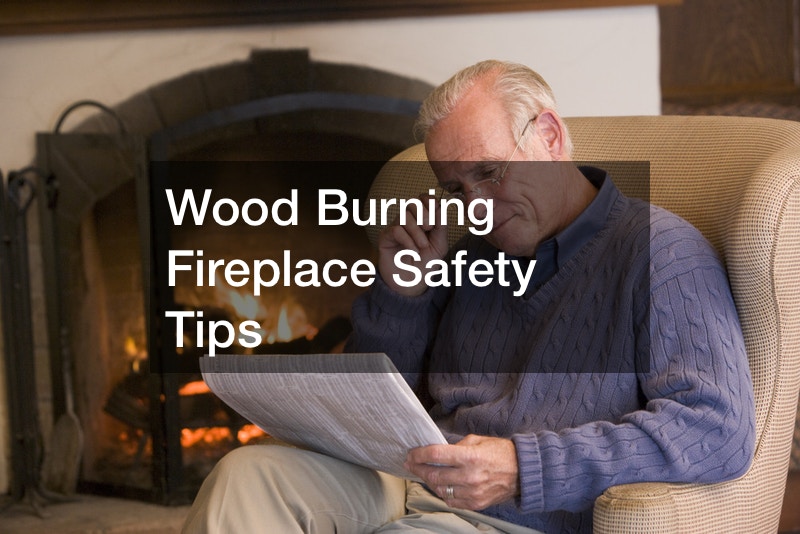
Creating a fire with logs is a great way to bring the cozy ambiance of the outdoors to your home. A properly constructed and maintained fireplace will also provide significant health and safety benefits. It will ensure your family members are safe while enjoying this new home addition. You can avoid unnecessary property damage or severe injury. Here are some helpful wood burning fireplace safety tips
Choose a Clean Surface to Situate Your New Fireplace

One of the wood burning fireplace safety tips is to ensure it is on a level surface. It should be away from any material that can catch fire or be damaged if it catches fire, including the walls and furniture in the room. Stay away from windows as well. They can break if they get too hot, which exposes your family and pets to dangerous temperatures and flying glass shards.
You may need to make room for your wood burning stone fireplace. A room with high ceilings may feel like an ideal place for a wood burning fireplace, but any chance of fire getting trapped in the chimney is just too great. Even if you are aware of the dangers, there’s nothing worse than having to put out a fire in your room.
If you’re not particularly happy with the design of your new wood burning fireplace, make sure it is painted white or a neutral color that is unseen by those in your living room or even your home office. You don’t want to be uncomfortable with it.
Select a Concrete or Stone Base to Install Your New Outdoor Fireplace On
When considering wood burning fireplace safety tips, you first want to install your new outdoor fireplace and select a concrete or stone base. It will ensure the outdoor fireplace you purchase is properly grounded and the immediate area around it is not prone to any electrical or water damage, so make sure you select a concrete paver stone for your outdoor fireplace.
Another decision to make when installing your new outdoor fireplace is how to best place it in your outdoor dining area. While you may want to place the outdoor fireplace close to your outdoor seating area, many people decide against doing this because it can make it hard for them to cook their food on the grill. Another mistake people make when installing an outdoor fireplace is placing a firebox too far from their outdoor seating area. If this is the case, guests may have difficulty getting their food and drinks before the fire cooks them.
Many fires start when the base of the structure collapses and the fire catches on some flammable material underneath it. Make sure that the concrete is as level as possible and that there is no debris under it before you begin construction. A brick, block, or sturdy wooden surface will be best as they are difficult to tip over.
Use a Non-Flammable Material to Construct the Base
Using a non-flammable material is among the wood burning fireplace safety tips. It prevents starting a fire in an area where you have stored flammable materials. Make sure to use a non-flammable material such as stone or concrete for your fireplace structure. Also, ensure you select a material that is not easy to ignite. For example, a wooden frame can easily fall over if poorly constructed.
By taking advantage of non-flammable materials like stone and mortar in your fire pit’s construction, you can ensure that your family and friends stay safe.
If you have a fire pit, ensure an excellent sturdy cover made from solid aluminum, which will help guard against sparks and embers being cast into the air by your fire. Equipping your fire pit with hardscape pavers is an added measure to ensure the safety of the people around it. It does more than protect from harsh weather conditions; it also protects those sitting in the fire pit. Make sure to follow local laws about where you can place your fire pit, and always ensure that there is plenty of space around it to move freely and safely in an emergency.
Make Sure You Keep a Fire Extinguisher Nearby

One of the wood burning fireplace safety tips is to have a fire extinguisher nearby. Ensure you check your fire extinguisher regularly and have training on how to use it before an emergency happens. A properly installed fire pit will not go out of control, but in the rare event that it does, it is a good idea to have a fire alarm system close by to nip the problem in the bud.
The best course of action is always to ensure to put out your fireplace before going off for the night and that you never have any open flames nearby or near flammable objects while using it. It is helpful to keep fireplaces away from anything that could spark an explosion or cause the fire to spread. It can also help to wear non-flammable clothing and shoes and never leave fuel before an open fire.
The wood inside the firebox should be checked and cleaned regularly. If the wood has been left untouched for an extended period, it will dry out and could cause a spark to ignite a fire. You can also eliminate sawdust or other debris by burning it in the fireplace for about fifteen to twenty minutes. Building materials, glass, metal, or anything else that hot embers could ignite should be left far away from the fire.
Do Not Use Paint Thinner or Gasoline Near a Wood Burning Fireplace
These items can easily catch on fire and cause something like paint thinner to explode if they come into contact with a spark from your outdoor fireplace.
Outdoor wood burning fireplaces and stoves are becoming more popular for enjoying outdoor living. You can get a hearth’s warmth without heating your home. But it would help to be careful about some safety hazards with these units and pay attention to wood-burning fireplace safety tips.
Before you light up those logs, ensure that the area is clear from potential fuel sources such as paint thinner or gasoline. They are both highly flammable and can cause explosions if there’s too much in one place. In addition, don’t leave kids or pets around the fireplace without supervision because they may poke at it with sticks or metal pieces, which could also cause a fire hazard.
In addition to being a fire hazard, firewood processing and outdoor wood burning stoves are also bad for the environment. Most of them use lots of wood pellets that can go into the ground or stream and lead to deforestation.
Install a Spark Screen to Help Contain the Sparks That Fly Out the Fireplace

Installing a spark screen is one of the wood burning fireplace safety tips. Not only will this keep the sparks from accumulating on top of the structure, but it will also help you keep your home a lot cleaner.
If you’ve just had a wood burning fireplace installed, you may consider installing a spark screen to help contain the sparks that can fly out of your new fireplace.
A spark screen is often built into the fireplace or can be purchased separately and transported to your home with the help of a material hauling service and easily installed on top of the chimney opening. A spark screen keeps any hot sparks from escaping from your new wood stove, which could potentially ignite other objects outside the firebox area.
A spark screen can be an inexpensive waywood to protect wood burning appliances without giving up their traditional look. With just a couple of short hours of labor, you can install a spark screen on your new wood burning appliance to help protect the areas around your home from fire hazards.
Do Not Use a Fire Pit in High Wind Conditions
Checking the forecast before using your new outdoor fireplace is one of the wood burning fireplace safety tips. The wind is even more unpredictable when you are dealing with the woods. Walking through the forest one day can lead to spectacularly beautiful scenes of dancing trees and various wildlife, but it can also turn into a nightmare sometimes. Never underestimate how quickly the winds can change for no apparent reason. When using a fire pit in windy conditions, it is essential to remember that the fire can start easily and spread very quickly.
If you’re using a fire pit outdoors, you need a safe area away from any structure or building to start your fire. If you have a large region, such as an open campsite, get permission from the owner or land manager. It is also crucial to have sufficient water supplies nearby and that they are easily accessible, with several open areas available if needed. Always be sure that you tell someone about the fire ring location in an emergency and ensure to contact fire hydrant service providers.
Use a Metal Mesh Screen to Keep Flying Insects Out of the Fire Pit Area
Installing a mesh is one of the vital wood burning fireplace safety tips. Sparks from the fire pit can quickly jump onto any dry food or pet droppings you have on your deck and ignite it. By keeping them away from potential fuel sources, you can regularly avoid this common catastrophe that firefighters and fire restoration services handle.
A metal mesh screen will keep flying insects away from your outdoor fire pit. It is a cost-effective way to enjoy the fire without the annoyance of smoke, ashes, and other airborne debris drawn by emissions from a flame.
Keeping the area around a backyard fire pit clean and clear of potentially hazardous objects is always best to maintain safety standards. When using standard logs, it’s also essential to monitor how quickly they turn into ash.
Even if you don’t have many bugs near your outdoor fire pit, using a mesh screen will help keep them away. It will also allow for better airflow for those who sit close by without being bothered by smoke and ash.
Keep the Area Around Your New Fireplace Clear

One of the best wood burning fireplace safety tips is to keep the area around the fireplace clear of any other materials. If something is too close to your fireplace, it could catch fire and pose a significant hazard.
If you’re planning on adding a fire pit to your backyard, there are a few things you need to know. To start with, make sure the area is clear of any obstacles. You’ll want to see through the pit’s opening to keep your eye on what’s going on without having anything inside it.
Next, ensure that no dry leaves or other flammable materials are within reach of the fire pit. By keeping these things away and only allowing combustibles near it like wood or charcoal, you’ll increase your chances of a safe burn. It is also vital to contact a brick sealing service to seal your fireplace.
Check Your Fireplace Regularly
One of the wood burning fireplace safety tips is to check your fireplace regularly. It ensures that no debris is caught in it. It is also vital to do a fire alarm inspection frequently.
Both novice and experienced wood burning fireplace owners should keep an eye on their fire mouths or any place that sticks and weeds might get in, so they can clean them out when necessary. It’s not uncommon for a small stick to get loose and fly into the fireplace or across where people might be sitting, with potentially dangerous effects.
In conclusion, wood burning fireplaces are a terrific and beautiful addition to a home, but only if you consider the essential wood burning fireplace safety tips. Proper maintenance, preparation, safety measures, and precautions allow your wood-burning fireplace to be a safe and reliable heat source for many years.
With all the potential dangers of a wood burning fire pit, it is essential to use your fire pit in the safest way possible. It’s important to remember that a wood burning stove rarely needs any maintenance and is likely the most environmentally friendly heating option. If you have one in your home, use it responsibly and always make sure you have an extinguisher nearby.




Leave a Reply
You must be logged in to post a comment.